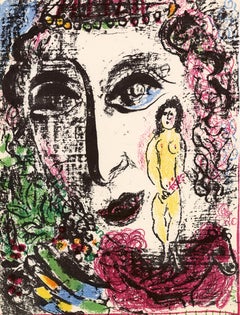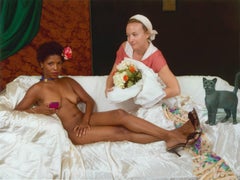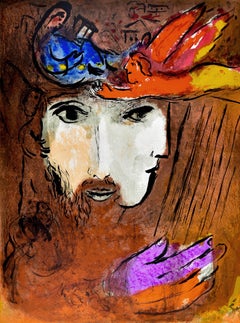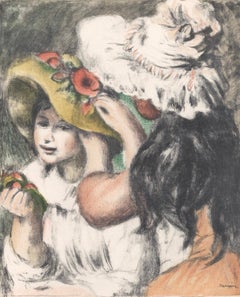Women Figurative Prints
to
2,256
7,840
2,538
2,480
1,085
644
Overall Width
to
Overall Height
to
5,064
2,591
1,146
732
485
413
381
315
221
118
92
31
19
1
537
178
168
147
120
1,106
2,712
8,870
1,956
151
250
623
474
461
772
1,131
1,724
925
405
924
9,974
4,202
396
26,722
14,645
10,471
8,979
7,644
6,979
4,524
4,098
2,356
2,027
1,920
1,867
1,701
1,469
1,465
1,461
1,459
1,274
1,221
1,160
5,741
4,379
1,875
1,048
949
1,397
7,027
6,604
5,668
Art Subject: Women
Waiting in the Wings
Located in Toronto, ON
38.5" x 25" Unframed
Limited Edition Hand Printed Lithograph of 100
Hand Signed by Douglas Hofmann
Category
21st Century and Contemporary Figurative Prints
Materials
Lithograph
L'Apparition au Cirque (Apparition at the Circus)
By Marc Chagall
Located in Milwaukee, WI
Framed 26 x 22 in
No. 392 in the Catalogue Raisonne of Chagall's lithographs
This lithograph came from "The Lithographs of Chagall: Volume II" by Fernand Mourlot and Marc Chagall....
Category
1960s Figurative Prints
Materials
Lithograph
Le Déshabille, Impressionist Etching with Aquatint by Manuel Robbe, circa 1907
By Manuel Robbe
Located in Long Island City, NY
This etching with aquatint was created by French printmaker Manuel Robbe. Robbe’s innovative techniques, along with his sense of color harmony and his choice of subjects: stylish wom...
Category
Early 1900s Impressionist Figurative Prints
Materials
Etching, Aquatint
Ode to Manet's Olympia
Located in New Orleans, LA
12 x 16 inches - Edition 2 of 7 with 2 APs
framing is an additional $265.
Shot in New Orleans in 2011, background illustrated by Marco Ventura
Inspired by Manet’s Olympia...
Category
21st Century and Contemporary Contemporary Figurative Prints
Materials
Archival Pigment
David and Bathsheba
By Marc Chagall
Located in OPOLE, PL
Marc Chagall (1887-1985) - David and Bathsheba
Original Lithograph from 1956.
Dimensions of work: 35 x 26 cm.
Publisher: Tériade, Paris.
Reference: Mourlot 132.
On the reverse: a...
Category
1950s Modern Figurative Prints
Materials
Lithograph
Pierre-Auguste Renoir, The Pinned Hat, Color State, 1951 (after)
Located in Southampton, NY
This exquisite lithograph after Pierre-Auguste Renoir (1841–1919), titled Le chapeau epingle, etat en couleur (The Pinned Hat, Color State), from the album Les Lithographies de Renoi...
Category
1950s Impressionist Figurative Prints
Materials
Lithograph
$716 Sale Price
20% Off
Toshogu Shrine
Located in Middletown, NY
In image of the Tokugawa family paying homage to Tosho-gu Shrine in Nikko.
Tokyo: Matsuki Heikichi, 1896
Woodcut in ink with embossing and hand-coloring in watercolor on handmade m...
Category
Late 19th Century Edo Figurative Prints
Materials
Watercolor, Handmade Paper, Woodcut
Vanade (Vanity) - Belgian Surrealism Muses
By Paul Delvaux
Located in London, GB
This original lithograph is hand signed by the artist in pencil "P. Delvaux" at the lower right margin.
It is also hand inscribed ‘HC 10’ in pencil at the lower left margin. This is ...
Category
1970s Surrealist Figurative Prints
Materials
Lithograph
EVENING THOUGHTS Signed Lithograph, Young Black Woman, Color Collage Portrait
Located in Union City, NJ
EVENING THOUGHTS is an original limited edition lithograph by the Harlem Renaissance, American social realist artist, ERNEST CRICHLOW (1914-2005) printed in 2002 at J K Fine Art Edi...
Category
Early 2000s Contemporary Portrait Prints
Materials
Lithograph
Serie Oratorios
Located in Toronto, ON
44" x 30" Unframed
3 Ink Woodcut Print on Paper
Hand Signed by Iván Bautista
Category
2010s Figurative Prints
Materials
Woodcut
Vivien in White Coat, 2021
By Alex Katz
Located in Palo Alto, CA
Alex Katz Vivien in White Coat, 2021 is a work of subtle admiration that the artist holds for her daughter-in-law, Vivien Bittencourt. The gentle hues...
Category
2010s Contemporary Portrait Prints
Materials
Screen
''Joy'' Limited edition print of surrealistic collage with portrait of a woman
By Maria Rivans
Located in Utrecht, NL
Maria Rivans is a contemporary British artist, known for her scrapbook-style collage aesthetic. A mash-up of Surrealism meets Pop-Art, Rivans’s work re-ap...
Category
2010s Contemporary Figurative Prints
Materials
Paper, Mixed Media
Ode to the Pinching D'Estrées Sisters
Located in New Orleans, LA
16 x 24 inches - Edition 3 of 5 with 2 APs
Available framing $420
Shot in 2011 in Amsterdam
Inspired by an anonymous artist of the Fontainebleau School’s Presumed Portrait of Gabr...
Category
21st Century and Contemporary Contemporary Figurative Photography
Materials
Archival Pigment
Study for Ovid-Windfall
By Chris Ofili
Located in Toronto, Ontario
Chris Ofili (b. 1968), a member of the Young British Artists, is renowned for his vibrant, multi-layered works that celebrate Afrocentrism through both figurative and abstract approa...
Category
2010s Contemporary Figurative Prints
Materials
Paper, Giclée
Repos sur la banquette
Located in London, GB
Henri Matisse
Repos sur la banquette
1929
Lithograph on Arches Velin paper, Edition of 50
Paper size: 49.5 x 65.5 cms (19 1/2 x 25 3/4 ins)
Image size: 44.5 x 54.5 cms (17 1/2 x 21 1...
Category
1920s Modern Figurative Prints
Materials
Lithograph
French Mid-Century 1962 Fashion Design Vintage Lithograph Print
By Jean Darroux
Located in Melbourne, Victoria
French fashion design published as a Supplement to 'L'Homme', a Parisien fashion periodical. Darroux was a Parisien tailor, who designed several ...
Category
Mid-20th Century Post-War Figurative Prints
Materials
Lithograph
Hebdomeros - Lithograph by Giorgio De Chirico - 1929
Located in Roma, IT
"Hebdomeros" is an hand-signed colored lithograph realized by Giorgio de Chirico in 1929.
This is an edition of 100 prints, and is part of the series "Metamorphosis: Suite de Six Lithographies", editions des Quatre-Chemins, 1929.
Very good condition.
Numbered. Edition, 88/100.
Bibliography: A. Ciranna, " G. De Chirico: Catalogo dell’Opera Grafica 1921-1969 ”, Roma, edizione " La Medusa ", 1969, p. 33, n. 13.
The widely renowned precursor of Surrealism was the Italian painter Giorgio de Chirico (1888-1978). De Chirico’s definitely ambiguous artworks of cityscapes are the most celebrated examples of a movement called Pittura Metafisica , or Metaphysical Painting.
Category
1920s Modern Figurative Prints
Materials
Lithograph
Jean Cocteau - Portrait - Original Etching
By Jean Cocteau
Located in Collonge Bellerive, Geneve, CH
Jean Cocteau - Portrait - Original Etching
Paris, Le Gerbier, 1946
Edition of 340
Signed in the plate
Unnumbered as issued
Category
1940s Modern Portrait Prints
Materials
Etching
Le Buste - Etching - 1960s
Located in Roma, IT
Etching on chamois-colored laid paper, realized by Dalì in 1968/69.
Plate from "Faust (La Nuit de Walpurgis), published by Argillet, Paris.
Edition of 49/150, hand colored.
Hand s...
Category
1960s Surrealist Figurative Prints
Materials
Etching
Indigenous People, North America, mid 19th century lithograph.
Located in Melbourne, Victoria
'Fisom degli abiti dell' America Nord-oe / Uomo donna dell' Isola Nootka' / 'Nipissonghi / Ottovaeri'
Italian lithograph, c1841. Originally from 'Galleria universale di tutti i popo...
Category
Mid-19th Century Naturalistic Figurative Prints
Materials
Lithograph
Santos Balmori Picazo "Two Women and A Cat" 1990 Silkscreen 41x28in figurative
Located in Miami, FL
Santos Balmori Picazo (Mexico, 1899-1992)
'Dos mujeres y un gato' (Two women and a cat), 1990
silkscreen on paper Guarro Super Alpha 250g.
41.25 x 28.25...
Category
1990s Contemporary Prints and Multiples
Materials
Screen
Lady with Flowers /// Pop Art Walasse Ting Colorful Girl Abstract Lithograph Art
By Walasse Ting
Located in Saint Augustine, FL
Artist: Walasse Ting (Chinese-American, 1929-2010)
Title: "Lady with Flowers"
*Signed and numbered by Ting in pencil lower left
Year: 1979
Medium: Original Lithograph on Somerset pap...
Category
1970s Pop Art Figurative Prints
Materials
Lithograph
Pink Composition - Lithograph by Max Ernst - 1974
By Max Ernst
Located in Roma, IT
Color lithograph realized by Max Ernst in 1974.
Not signed. as issued.
Printed by Atelier Pierre Chave in Vence, France. Excellent condition.
This lithograph was realized by th...
Category
1970s Surrealist Figurative Prints
Materials
Lithograph
The Woman with the Butterfly - Original Lithograph Signed
By Yves Ganne
Located in Paris, IDF
Yves GANNE (1931-2019)
The Woman with the Butterfly
Original Lithograph
Signed on pencil
Numbered on 150 copies
On vellum Arches 53.5 x 76 cm (c. 21.06 x 29.92 in)
Very good condit...
Category
Late 20th Century Modern Figurative Prints
Materials
Lithograph
Leonor Fini - Dressed-up - Original Lithograph
By Leonor Fini
Located in Collonge Bellerive, Geneve, CH
Leonor Fini - Dressed-up - Original Lithograph
The Flowers of Evil
1964
Conditions: excellent
Edition: 500
Dimensions: 46 x 34 cm
Editions: Le Cercle du Livre Précieux, Paris
Unsig...
Category
1960s Modern Nude Prints
Materials
Lithograph
Vintage Chinese Deco Calendar Poster for White Horse Cigarettes, c. 1936
Located in Chicago, IL
This calendar advertisement poster for White Horse cigarettes was produced by Hu Boxiang, a famous commercial advertising artist in Shanghai during th...
Category
Early 20th Century Art Deco Figurative Prints
Materials
Paper, Ink
PRECIOUS MOMENTS
By Pino Daeni
Located in Aventura, FL
Giclee on on deluxe paper. Hand signed and numbered on front by the artist. Image size 19.25 x 26 in. Frame size approx 27 x 34 in. Artwork is in excellent condition. Certificate o...
Category
21st Century and Contemporary Impressionist Portrait Prints
Materials
Paper, Giclée
$1,050 Sale Price
30% Off
La Persane
Located in London, GB
Henri Matisse
La Persane
1929
Lithograph on Arches Velin paper, Edition of 50
Paper size: 63 x 44.5 cms (24 3/4 x 17 1/2 ins)
Image size: 44.8 x 29 cms (1...
Category
1920s Modern Figurative Prints
Materials
Lithograph
Domergue - Elegance - Original Signed Lithograph
Located in Collonge Bellerive, Geneve, CH
Original Lithograph by Jean-Gabriel Domergue
Title: Elegance
Signed in the plate
Dimensions: 40 x 31 cm
1956
Edition of 197
This artwork is part of the famous portfolio "La Parisienne"
Category
1950s Impressionist Portrait Prints
Materials
Lithograph
Pianos y caracolas
Located in Ciudad de México, MX
Pedro Friedeberg’s screen prints are not just artworks. They're vibrant windows into a surreal, imaginative world that blends architectural pre...
Category
2010s Contemporary Figurative Prints
Materials
Screen
The Fair
Located in Storrs, CT
The Fair. 1895-96. Lithograph. Way 92, Levy 144, Tedeschi, Stratis and Spink 135 state ii. Image 9 1/4 x 6 1/2 (sheet 13 x 9 5/8). A fine impression printed on antique cream-laid paper. Way lists 15-lifetime impressions (Goulding printed...
Category
Late 19th Century American Modern Figurative Prints
Materials
Drypoint, Etching
$2,450 Sale Price
30% Off
Massimo Vitali MARINA DI MASSA Lithograph, 26"H x 34"W
Located in Lake Worth Beach, FL
Artist/Designer; Manufacturer: Massimo Vitali (Italian, b. 1944)
Marking(s); notes: artist's stamp verso; ed. 59/120; 2006
Materials: offset lithograph
Dimensions (H, W, D): 26.75"h,...
Category
Early 2000s Contemporary Figurative Prints
Materials
Lithograph, Offset
'A Morning in May' — Ashcan School Social Realism, New York City
Located in Myrtle Beach, SC
Reginald Marsh, 'A Morning in May', etching, 1936, edition 100 (Whitney, 1969), Sasowsky 169. Unsigned as published; numbered '89/100' in pencil. A superb, richly-inked impression, ...
Category
1930s Ashcan School Figurative Prints
Materials
Etching
French Contemporary Art by Claudine Loquen - Aliénor D'Aquitaine En Croisade
Located in Paris, IDF
Claudine Loquen is a French artist born in 1965 who lives and works in Sassetot-le-Mauconduit, France.
Like Colette with the literature, the artist makes the apology of painting wi...
Category
2010s Contemporary Figurative Prints
Materials
Handmade Paper, Etching
Realization I, by Chicano artist Eloy Torres
Located in Palm Springs, CA
Acrylic paint on canvas, image of a nude angel unfurling her wings against a turbulent seascape.
Torres is best known to most people for his monumental mural "Pope of Broadway", a p...
Category
1990s Contemporary Nude Paintings
Materials
Acrylic
$1,000 Sale Price
20% Off
Serie Inflorescencias
Located in Toronto, ON
11 1/2 × 15 in Unframed
2 Ink Linoleum Print on Paper
Hand Singed by Iván Bautista
Category
2010s Figurative Prints
Materials
Linocut
Caius Julius Caesar Octivanius Augustus, Dadaist Aquatint Etching by Enrico Baj
By Enrico Baj
Located in Long Island City, NY
Artist: Enrico Baj, Italian (1924 - 2003)
Title: Caius Julius Caesar Octivanius Augustus
Year: 1972
Medium: Aquatint Etching with Collage, Signed and numbered in pencil
Edition: 24/7...
Category
1970s Conceptual Portrait Prints
Materials
Mixed Media, Etching, Aquatint
Hendrix
By Ronnie Wood
Located in Toronto, ON
24 1/2" x 18 3/4" Unframed
Multi-block Wood on Somerset Banks Cream 300gsm
Hand Singed by Ronnie Wood
Category
21st Century and Contemporary Figurative Prints
Materials
Woodcut
$4,000
Marocains Jouant avec un Vautour - Etching by Eugène Champonnion - 1871
Located in Roma, IT
Etching in paper realized by Eugène Champonnion after Mariano Fortuny.
Signed "Fortuny 68" loer right, in the plate.
Foreground Figures:
Two Moroccan men are seated on the ground. ...
Category
1870s Modern Figurative Prints
Materials
Etching
Ode to van der Weyden's Portrait of a Lady
Located in New Orleans, LA
24 x 16 inches - Edition 1 of 5 with 2 APs
framing is an additional $420.
Photography and acting are kindred spirits in the new series by e2 (Elizabeth Kleinveld and Epaul Julien)....
Category
2010s Contemporary Figurative Photography
Materials
Archival Pigment
Amsterdam Signed Limited Edition Lithograph Large
By Ernesto
Located in Rochester Hills, MI
Artist Name: Ernesto Amsterdam
Title: Capturing the Essence of Amsterdam:
Medium Type: Lithograph on Arches Archival Pape
Size-Width Size-Height: 46½'' x 28¾'' inches
Signed Edit...
Category
1990s Post-Modern Figurative Prints
Materials
Lithograph
Ode to Goya's Maya
Located in New Orleans, LA
24 x 36 inches - Edition 1 of 3 with 2 APs
framing is an additional $525.
Photography and acting are kindred spirits in the new series by e2 (Elizabeth Kleinveld and Epaul Julien)....
Category
21st Century and Contemporary Contemporary Figurative Photography
Materials
Archival Pigment
A Calvary Skirmish - by Jan van Huchtenburg
Located in Middletown, NY
Haarlem: c1700.
Mezzotint on watermarked laid paper, 11 1/2 x 18 1/4 inches (290 x 462 mm), thread margins. In good condition with expert repairs at the right corners, and upper-lef...
Category
18th Century Portrait Prints
Materials
Laid Paper, Mezzotint
Les Sorcières de Mechlin (The Witches of Mechlin) - Lithograph - 1846
Located in Roma, IT
Lithograph after Alexandre-Gabriel Decamps (1803–1860).
This striking lithograph by Eugène Le Roux interprets a dramatic composition by Alexandre-Gabriel Decamps, one of the leading...
Category
1840s Modern Figurative Prints
Materials
Lithograph
Sliding
Located in New York, NY
ABOUT THIS ARTIST: Jessica Brilli (Sayville, NY 1977) has been drawing and painting since her childhood. Working in a style that encompasses American realism and 20th century graphic...
Category
2010s Figurative Prints
Materials
Photographic Paper
Flapper
By Erté
Located in Washington, DC
Artist: Erté
Title: Flapper
Medium: Embossed serigraph
Year: 1990
Edition: CCXXII/CCC
Sheet Size: 41 3/4" x 29 1/4"
Image Size: 35 1/4" x 23 1/4"
Signature: Stamped signature
Category
1990s Surrealist Figurative Prints
Materials
Screen
$1,195
Lady with a Poodle on a Rainy Street (Carriage to the Left) - Impressionist
By Lesser Ury
Located in London, GB
This original etching is hand signed in pencil by the artist "L. Ury" at the lower left margin.
It is a signed proof from an edition of unknown size. It is a particularly rare subjec...
Category
1920s Impressionist Figurative Prints
Materials
Etching
Original Australia, Australian Rules - VFL (AFL) vintage Football sports poster
Located in Spokane, WA
Original Australia Sports Poster – Vintage Australian Rules Football– Iconic AFL, archival linen-backed, very fine condition, ready to frame. Printed for the Australian Tourist Com...
Category
1960s American Realist Figurative Prints
Materials
Offset
"Untitled (Love)" mixed media artwork by artist Raphael Mazzucco
Located in Boca Raton, FL
"Untitled (Love)" mixed media work by artist Raphael Mazzucco. A feather on twine floats floats loose and can dangle below the frame.
Category
2010s Contemporary Portrait Prints
Materials
Mixed Media
Night: William Dunas Dance, Suite of Four Lithographs by Alex Katz
By Alex Katz
Located in Long Island City, NY
A beautiful set of prints displaying a dancer (Pamela) in motion. Pamela is a recurring subject in Alex Katz’s work, regularly showing up named in the titles of various pieces. This ...
Category
1970s Contemporary Figurative Prints
Materials
Lithograph
Naked Woman on a Mound by Rembrandt van Rijn
Located in New Orleans, LA
Rembrandt van Rijn
1606-1669 Dutch
Naked Woman on a Mound
Etching on paper
Etched by Rembrandt
New Hollstein 88, second state of II; Bartsch, Hollstein 198; Hind 43
One of the gr...
Category
17th Century Old Masters Figurative Prints
Materials
Etching
"Song of Breezes"
Located in Los Angeles, CA
Lilian Shao, China. "Song of Breezes", 1990
Limited edition Serigraph printed on paper. Hand signed by the artist in pencil on the lower right and the edition number 183/275 on the l...
Category
Late 20th Century Figurative Prints
Materials
Color
Silhouetted Figures, Surrealist Lithography by Marisol Escobar
Located in Long Island City, NY
Artist: Marisol Escobar, French/Venezuelan (1930 - 2016)
Title: Silhouetted Figures
Year: 1979
Medium: Lithograph, signed and numbered in pencil
Edition: AP 15
Size: 44 in. x 30 in....
Category
1970s Abstract Expressionist Figurative Prints
Materials
Lithograph
Guerriers Tcherkesses et Cosaques de l’Elbourz-Lithograph by Auguste Raffet-1842
Located in Roma, IT
Lithograph on wove paper realized in 1842. Signed and dated in the plate.
Image dimension: 34.5x24.5
A powerful composition by Auguste Raffet, depicting Circassian warriors and Cos...
Category
1840s Modern Figurative Prints
Materials
Lithograph
"Our work was fun", Linocut, signed
Located in Slovak Republic, SK
Linocut, signed, reminding the depicts of the paradox of social realism showing happy people but the reality was cruel.
Category
21st Century and Contemporary Realist Figurative Prints
Materials
Linocut
Original 1912 Roma Vintage Opera poster by Georges Rochegross
Located in Spokane, WA
Rare Original 1912 Théâtre National de L'Opéra Paris Poster - ROMA Opera - Rochegrosse Art - Jules Massenet - Classical Theater Collectible. This poster is archival, linen-backed, ...
Category
1910s Art Nouveau Figurative Prints
Materials
Lithograph
Guardians of the Spire (Amiens Cathedral Number 2)
Located in Storrs, CT
Guardians of the Spire (Amiens Cathedral Number 2). 1921. Etching. Fletcher 102. 6 3/4 x 9 7/8 (sheet 8 7/8 x 13 3/4). Gargoyle Series #4. Edition 75. Illustrated: Dorothy Noyes Arms...
Category
1920s American Modern Landscape Prints
Materials
Drypoint, Etching
$2,000 Sale Price
20% Off
Ode to Vermeer's Girl with a Pearl Earring
Located in New Orleans, LA
36 x 30 inches - Edition AP2 of 3 with 2 APs
Framing is an additional $525
Shot in 2012 in Amsterdam
Inspired by Vermeer’s The Girl with a Pearl Earring...
Category
21st Century and Contemporary Contemporary Figurative Photography
Materials
Archival Pigment
Alphonse Mucha 1896 Lorenzaccio Theatre De La Renaissance
Located in Dallas, TX
Alphonse Mucha (Czech, 1860-1939) Lorenzaccio
Printed: 1896
Printed By: F. Champenois, Paris
Hand signed in lower left.
Signed in plate; Mucha,
F. Champenois, Paris
Lithograph paper ...
Category
1890s Art Nouveau Figurative Prints
Materials
Lithograph
Guitar Player- Lithograph by Alfredo Romagnoli - 1970s
Located in Roma, IT
Guitar Player is a Lithograph realized by Alfredo Romagnoli in 1970s.
The artwork is in good condition on a white cardboard.
Hand-signed by the artist on the lower right corner.
Alfredo Romagnoli (January 5, 1915 in Genzano di Roma - March 21, 2008 in Rome) was an Italian painter. He studied first at the School of Sacred Art...
Category
1970s Contemporary Portrait Prints
Materials
Lithograph



